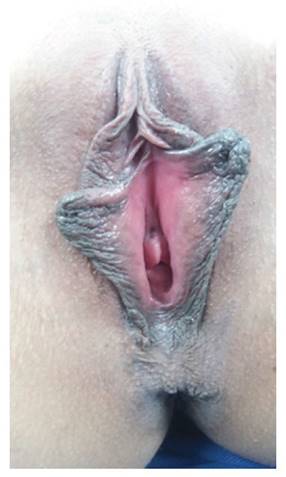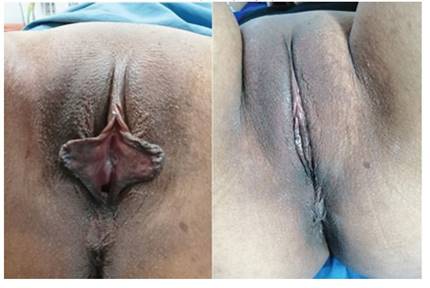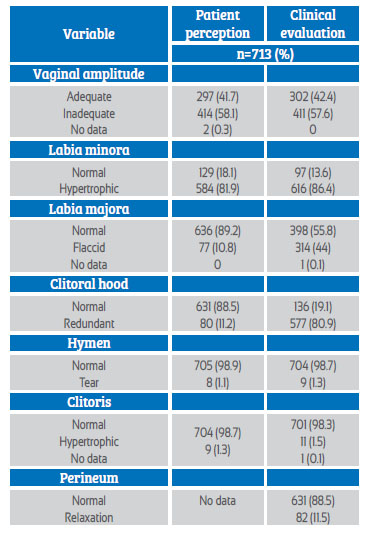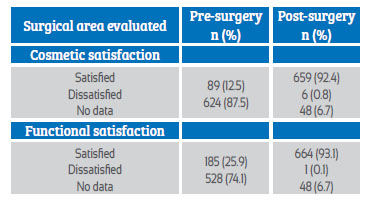Servicios Personalizados
Revista
Articulo
Indicadores
-
 Citado por SciELO
Citado por SciELO
Links relacionados
-
 Similares en
SciELO
Similares en
SciELO
Compartir
Revista Peruana de Ginecología y Obstetricia
versión On-line ISSN 2304-5132
Rev. peru. ginecol. obstet. vol.68 no.1 Lima ene./mar. 2022 Epub 24-Feb-2022
http://dx.doi.org/10.31403/rpgo.v68i2385
Original Articles
Labiaplasty and genital cosmetic surgery techniques in Medellin, Colombia
1Obstetrician and Gynecologist, expert in Cosmetic, Regenerative and Functional Laser Aesthetics.
2Obstetrician and Gynecologist, UniRemington
3Physician, Master in Epidemiology and Public Health, Biomedical Research Group, UniRemington
Introduction
: Female genital aesthetic surgery is in increasing demand; however, its technique and results are not well known. Objectives: To describe the sociodemographic data, clinical manifestations, postoperative results and satisfaction in a group of women who underwent female genital cosmetic surgery.
Methods
: Descriptive, retrospective study of an institutional database, in the period March 6, 2007 to January 14, 2021. Demographic and clinical data from medical records were analyzed using descriptive statistics. Results: Data were retrieved for 713 patients, mean age 34.3 years, 12 of whom were younger than 18 years. Before the intervention, 87.5 % (n= 624) of patients were dissatisfied with the appearance of their external genitalia, 74.1 % (n= 528) had discomfort with their genitalia and 53.4 % (n= 381) reported loss of sexual gratification. The most common findings on physical examination were hypertrophy of the labia minora (n= 616; 86.4 %) and redundant clitoral hood (n= 577; 80.9 %). The most commonly performed surgery consisted of labiaplasty (n= 609; 85.4 %) and clitoral hood reduction (n= 564; 79.1 %). Overall satisfaction at 8 and 30 days was 99.4 % (n= 709) and 93.3 % (n= 665), respectively.
Conclusions
: In the cohort studied, women achieved high rates of cosmetic satisfaction with surgical results and improvement in their functional satisfaction. There was a low rate of complications.
Key words: Vulva; Surgery; plastic; Cosmetic techniques
INTRODUCTION
Female genital cosmetic surgery (FGCS) is defined as a vaginal or labial surgical technique with esthetic or functional intent1. In the field of gynecology, an increase in the number of patients is observed. Modern trends have shifted towards lack of pubic hair, making subtle labial irregularities more noticeable2). The most commonly related abnormality is labia minora hypertrophy and redundant clitoral hood. Figure 1.
Labiaplasty is the most frequently performed (FGCS) by plastic surgeons or gynecologists. In the United States, 5,070 procedures were performed in 2013 and about 12,000 in 2016, with an increase of 237 %3,4). The increase in requests is also observed worldwide1). Thus, the International Society of Aesthetic Plastic Surgery (ISAPS) describes an increase of 45% between 2015 and 20165).
The technique of labiaplasty involves resecting the exuberant and unwanted greater / lesser labial tissue, often bilaterally. The most commonly used techniques are linear cutting, jockey stick, de-epithelialization and wedge resection6).Figure 2.
The objective of vaginoplasty, also known as vaginal rejuvenation, is to tighten or restore the vaginal contour. The most commonly used methods are anterior, posterior or lateral colporrhaphy7).
Laser vaginal rejuvenation is used to improve symptoms of vulvovaginal atrophy, particularly in menopause, as it can increase the production of collagen and extracellular matrix with a consequent increase in the thickness of the vaginal epithelium, and potentially improve the contour of the vaginal caliber, increasing vaginal lubrication and tightening8).
Labia majora augmentation is another (FGCS) procedure. It is performed to modify the appearance of the labia majora by autotransplantation, fat injection or reticulate hyaluronic acid injection.
Hymenoplasty, also known as revirgination, is a controversial procedure that attempts to repair the hymen to a 'virginal' state. This is most often accomplished by suturing the remaining portions of the hymen back together, and is often performed in combination with vaginoplasty, to simultaneously decrease the caliber of the vagina.
The surgeries also aim to improve sexual gratification, for example, by intervening on the pubic mound, removing excess fatty tissue through liposuction. Clitoral hood resection (hoodectomy) describes the removal of excess tissue around the clitoris to improve sexual function by increasing sensitivity and allowing more direct contact with the clitoris during sexual activity. Finally, G-spot amplification involves injecting hyaluronic acid into the anterior vaginal wall, offering increased stimulation during intercourse7).
The objective of this study was to conduct a retrospective review of the sociodemographic data, clinical manifestations, postoperative results and satisfaction with genital cosmetic surgery of patients who attended the gynecology consultation in a genital aesthetic laser clinic in the city of Medellin, Colombia.
METHODS
This is a descriptive, retrospective study of women who underwent genital cosmetic surgery between March 6, 2007 and January 14, 2021.
As secondary sources of information, medical records of women who underwent genital cosmetic surgery were selected from the personal records of one surgeon ( JFBB), a gynecologist expert in genital aesthetic surgery and vaginal laser rejuvenation in the city of Medellin, located in northwestern Colombia.
Inclusion criteria were: female gender, esthetic or functional nonconformity with their external genitalia, congenital abnormalities or secondary to obstetric trauma, and previous unsatisfactory cosmetic surgeries. Exclusion criteria were if the women had records with relevant loss of information, women with body dysmorphic disorder or if they refused to undergo the intervention. After consecutive sequential sampling, 713 records were obtained. No cases were withdrawn; all were included in the analysis and were useful for the study.
After standardization of the research protocol, the information was collected, tabulated and verified in an Excel® database by the principal investigator JFBB. The following variables were evaluated in the study population: age, residence, marital status, obstetric history (pregnancy, births, cesarean section, live children). A heterodirected form was filled out by the principal investigator about cosmetic and functional satisfaction before and after the procedure, type of surgery, symptoms associated with the surgical procedure and complications.
The most frequently performed surgery was labiaplasty, using the linear laser cutting technique, also known as the edge method, according to Hodgkinson1. The area to be cut with the laser is marked with methylene blue, with mirror image in the ipsilateral lip to achieve symmetry between them, infiltration with lidocaine, placement of support stitches, cutting the redundant tissue with laser, decreasing the thickness of the lips and facing with subdermal stitches. It is imperative to leave a 1 cm cuff of labia minora to provide a functional 'seal' at the introitus.
Descriptive analysis of the sociodemographic and clinical variables was performed. Absolute frequencies and percentages, mean and standard deviation were calculated according to the nature and distribution of the variables. Normal distribution was validated using the Shapiro-Wilk goodness-of-fit test. Bivariate analysis was performed with the chi2 test to establish the association between cosmetic and functional satisfaction preand post-surgery. For hypothesis testing, a confidence interval of 95% and significance level of 5% were applied. SPSS statistics software version 23 was used.
In relation to ethical considerations, the present study is considered a study without risk, according to the classification set forth in Article 11 of Resolution No. 008430 of 1993 (issued by the Ministry of Health of Colombia), and complies with international standards, the Declaration of Helsinki, and the ethical guidelines for biomedical research prepared by the Council for International Organizations of Medical Sciences -CIOMS. The principal investigator JFBB has informed consent and authorization for the use of photographic records.
Between March 6, 2007 and January 14, 2021 (13 years, 10 months), following the criteria, 713 cases were included. The mean age was 34.3 years (SD 9.4), 84.7 % (n= 604) resided in Medellin, most were single (48.9 %; n= 349), followed by married women in 37.3 % (n= 266).
Within the obstetric history, the majority (40.5 %; n= 289) had not been pregnant and 59.5 % (n=424) had gestated. The majority had two pregnancies (23.7 %; n= 169), followed by those who had one pregnancy (20.9 %; n= 149). The most frequent delivery was vaginal in 53.5 % (n= 227), 106 cases had cesarean section and in 91 patients the pregnancy ended in abortion.
The most frequent reason for consultation was dissatisfaction with the esthetics of their external genitalia (87.5 %; n= 624), 74.1 % (n=528) reported genital discomfort with the use of underwear and with sports activity and 381 patients (53.4 %) informed loss of associated sexual gratification.
On physical examination, the most frequent finding was labia minora hypertrophy in 86.4 % (n= 616), followed by inadequate vaginal amplitude in 57.6 % (n= 411); the least frequent finding was clitoral hypertrophy in 11 cases (1.5 %) (Table 1).
Among the types of genital cosmetic surgery, the most frequent was minor reduction labiaplasty with laser in 85.4 % (n= 609), followed by resection of redundant clitoral hood in 79.1% (n= 564), vaginal rejuvenation with laser 39 % (n= 278), resection and tightening of redundant labia majora skin (lifting) in 38 % (n= 271), perineoplasty in 8.6 % (n= 61), clitoroplasty in 1.7 % (n= 12), hymenoplasty in 1.4 % (n= 10) and G-spot injection in one case (0.1 %).
There was bleeding of the wound edges in the immediate postoperative period in 429 cases (60.2 %), of which the majority was mild (n= 59.9; 99.5 %), and in 7 cases (1 %) hematoma was present, being in 3 cases mild (0.4 %) and in 4 cases moderate (0.6 %). There was dehiscence in 22 cases (3.1 %) and urinary retention in 6 cases (0.8%); 9 cases required reintervention (1.3 %) and there were no cases of wound infection.
The most common symptoms in the immediate postoperative period were genital edema in 59.3% (n= 423), mostly mild (n= 385; 54 %), followed by pain in 26.9 % (n= 192), burning in 4.9 % (n=35) and pruritus in 23 cases (3.2 %).
The evaluation of esthetic and functional satisfaction at preand 90 days post-surgery is presented (Table 2) and bivariate analysis is performed for overall satisfaction at preand 90 days post-surgery (Table 3).
DISCUSSION
This study gathers the largest number of cases reported in the world bibliography of female genital cosmetic surgery. Therefore, it contributes to the knowledge of the surgical technique, especially in Hispanic population, and analyzes the satisfaction associated to the surgical procedure.
The mean age in the present study was 34.3 years, similar to that found in other studies, with a range between 31.5 and 33.5 years9. Labiaplasty is the most frequently used procedure among female genital aesthetic surgeries; in this study it was performed in 85.4 % (n= 609). Few studies address the other techniques, partly because of their low frequency10.
This study showed that the main motivator to undergo labiaplasty was cosmetics, due to dissatisfaction with the appearance of the genitalia in 87.5% (n= 624), similar to what was found by Veale et al11), where the main symptom was cosmetic in 70.8% of the patients. Sharp et al12 observed that three quarters of the patients had cosmetic reasons as their main driver for labiaplasty.
The second most frequent motivation was discomfort with the external genitalia in 74.1 % (n= 528), while Veale et al11), found this to be the fourth most important concern. Miklos and Moore(13) in their study reported that 37% of patients had esthetic and 32% functional non-sexual reasons.
Sorice et al(14) related that poor perception of their genitalia affected their quality of life. One of the landmark studies describing the key motivations of women seeking labiaplasty reports reduced body image, sexual satisfaction and quality of life as the main motivators(11). The present study detected that 53.4 % (n= 381) considered loss of sexual gratification. Turini et al15 found a significant improvement in the total score of the female sexual function questionnaire in the domains of pain and enjoyment.
In Doyan and Yassa's study16, up to 30% of the women thought they had normal genitalia, and in the present study it was found that 12.5% (n=89) were satisfied with the appearance of their genitalia, and the motivation with surgery was to seek further improvement.
The literature describes high rates of patient satisfaction and low rates of complications associated with labiaplasty, Crépaux et al17) found 95 % satisfaction and 94 % functional improvement, Propst et al9) reported 95.2 % overall satisfaction. Sharp et al.12) noticed statistically significant rates of satisfaction with genital appearance (p <.001), sexual satisfaction (p = .009) and psychological well-being (p <.001) compared to their levels before surgery.
With the laser labiaplasty technique, Bizjak-Ogrinc et al(18) found an overall satisfaction of 100 %. In the present study of laser labiaplasty, overall satisfaction at 8 days was 99.4 % (n= 709), cosmetic 99.3 % and functional 99.3 %, with a low rate of complications.
The major limitations of this study were its retrospective nature, the heterodirected satisfaction survey of the interviewer may bias the responses, subjectivity may be present in the concept of beauty on the part of the patient and examiner, and the results correspond to a specific cohort in the experience of a gynecologist, which does not allow inferences in the experience of general practice.
In conclusion, in the cohort studied, women achieved high rates of cosmetic satisfaction with surgical outcomes, and also appeared to experience improvements in their functional satisfaction. Most were associated with physical/ functional motivations congruent with the physical findings. Surgery performed by a skilled gynecologist was safe and was associated with low complication rates.
REFERENCES
1. Liao LM, Creighton SM. Requests for cosmetic genitoplasty: how should healthcare providers respond? BMJ. 2007;334(7603):1090-2. doi:10.1136/bmj.39206.422269.BE [ Links ]
2. Schick VR, Rima BN, Calabrese SK. The portrayal of women's external genitalia and physique across time and the current barbie doll ideals. J Sex Res. 2011;48(1):74-81. doi:10.1080/00224490903308404 [ Links ]
3. Gowda AU, Chopra N, Khalifeh M. Indications, techniques and complications of labiaplasty. Eplasty. 2015 Aug 18;15:ic46. PMID: 26330896; PMCID: PMC4544281. [ Links ]
4. Cosmetic Surgery National Data Bank Statistics. Aesthet Surg J. 2017 May 1;37(suppl_2):1-29. doi: 10.1093/asj/sjx076 [ Links ]
5. Plastic Surgery Statistics | Global Plastic Surgery Statistics [Internet]. ISAPS. [citado 19 de octubre de 2021]. https://www.isaps.org/medical-professionals/isaps-global-statistics/ [ Links ]
6. Oranges CM, Sisti A, Sisti G. Labia minora reduction techniques: a comprehensive literature review. Aesthet Surg J. 2015;35(4):419-31. doi:10.1093/asj/sjv023 [ Links ]
7. Elective female genital cosmetic surgery: ACOG Committee Opinion, Number 795. Obstet Gynecol. 2020;135(1):e36-e42. doi:10.1097/AOG.0000000000003616 [ Links ]
8. Samuels JB, Garcia MA. Treatment to external labia and vaginal canal with CO2 laser for symptoms of vulvovaginal atrophy in postmenopausal women. Aesthet Surg J. 2019 Jan 1;39(1):83-93. doi: 10.1093/asj/sjy087 [ Links ]
9. Crépaux V, Legendre G. Nymphoplastie: motivations et satisfaction postopératoire. Gynécologie Obstétrique Fertil Sénologie. 2019;47(6):489-96. doi:10.1016/j. gofs.2019.04.005 [ Links ]
10. Propst K, Ferrando CA. Outcomes of labiaplasty in women with labial hypertrophy. Int Urogynecology J. 2021;32(5):1247-51. doi:10.1007/s00192-020-04621-w [ Links ]
11. Pauls RN. We are the correct physicians to treat women requesting labiaplasty. Am J Obstet Gynecol. 2014;211(3):218- 218.e1. doi:10.1016/j.ajog.2014.06.019 [ Links ]
12. Veale D, Eshkevari E, Ellison N, Costa A, Robinson D, Kavouni A, Cardozo L. Psychological characteristics and motivation of women seeking labiaplasty. Psychol Med. 2014;44(3):555-66. doi:10.1017/S0033291713001025 [ Links ]
13. Sharp G, Tiggemann M, Mattiske J. A retrospective study of the psychological outcomes of labiaplasty. Aesthet Surg J. Published online November 14, 2016:sjw190. doi:10.1093/asj/sjw190 [ Links ]
14. Miklos JR, Moore RD. Labiaplasty of the labia minora: patients' indications for pursuing surgery. J Sex Med. 2008;5(6):1492-5. doi:10.1111/j.1743-6109.2008.00813.x [ Links ]
15. Sorice SC, Li AY, Canales FL, Furnas HJ. Why women request labiaplasty: Plast Reconstr Surg. 2017;139(4):856-63. doi:10.1097/PRS.0000000000003181 [ Links ]
16. Turini T, Weck Roxo AC, Serra-Guimarães F, Abreu ML, de Castro CC, Aboudib JH, et al. The impact of labiaplasty on sexuality. Plast Reconstr Surg. January 2018;141(1):87-92. doi:10.1097/PRS.0000000000003921 [ Links ]
17. Dogan O, Yassa M. Major motivators and sociodemographic features of women undergoing labiaplasty. Aesthet Surg J. 2019;39(12):NP517-NP527. doi:10.1093/asj/sjy321 [ Links ]
18. Bizjak-Ogrinc U, Sencar S. Sutureless laser labiaplasty of labia minora. Sex Med. 2021;9(5):100406. doi:10.1016/j.esxm.2021.100406 [ Links ]
Received: September 27, 2021; Accepted: December 01, 2021











 texto en
texto en 








